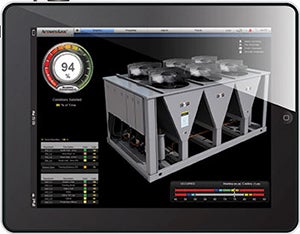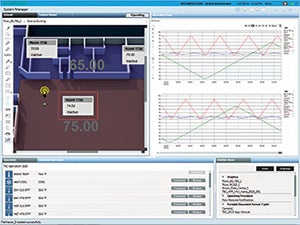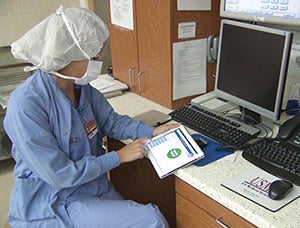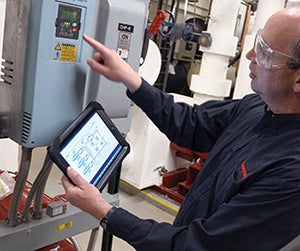Smarter integration of building controls
The capabilities of building automation systems (BASs) have expanded significantly over the past several years. New systems are more complex and smarter than ever. BASs are being used to monitor and control HVAC equipment, lighting and occupancy in hospitals. Energy management also is a big focus today and the tools to monitor and measure those variables are more sophisticated.
Facilities managers now have the tools to automate the process of collecting this data, archiving it and emailing it to whomever needs it. This is more evident in hospitals where the BAS is being used to generate reports for Joint Commission compliance, says Victor Saeh, LEED AP BD+C, CEM, existing buildings commissioning services operations manager, Smith, Seckman, Reid Inc., an engineering consulting firm based in Nashville, Tenn.
Recent advances have been in the areas of specialized dashboard interfaces for monitoring critical facilities areas, integration of patient-scheduling software, and specialized interfaces for such nontraditional BAS users as patients and nurses who need to be able to quickly adjust to conditions in occupied areas.
Increasing compliance and clinical accountability needs are driving smarter integrations and new applications to hospital BASs, says Mark Reinbold, vice president of energy solutions sales for Johnson Controls, Milwaukee. “A good example can be found in the operating room where we are linking the BAS with surgical scheduling to optimize energy use in the often-unoccupied OR suite, while increasing clinical productivity and reducing risk through surgical event and environmental documentation dashboards. We also are improving technology integration in patient rooms through new temperature and lighting controls.”
The industry is advancing as cloud-based energy management platforms easily communicate with other complex business, clinical and building systems, according to Reinbold. “Software as a service adds even greater value to a BAS investment. We help users to collect all that data from multiple BASs via the cloud, normalize it and deliver it in an easy-to-use application.”
Back to the basics
Hospital BASs are undergoing a paradigm shift back to the basics of energy management, says Sean Goings, CEM, CHSP, SASHE, manager of U.S. Healthcare Solutions, Schneider Electric, Andover, Mass. “Once used primarily to maintain patient comfort and environmental parameters, BASs are now largely responsible for consolidating technical infrastructure and optimizing hospital operations. Much of this renewed focus can be attributed to the financial pressure hospitals are under in the current reform climate,” he notes.
Internal or external dashboards and automatic fault detection and diagnostics (AFDD) are important tools for saving energy. Many hospitals with large campuses are looking at energy dashboards as a way to encourage healthy energy-reduction competition between facilities managers. In some instances, energy dashboards are used to show the public that they are spending money wisely.
“Building managers can incorporate all BAS information into a dashboard that is easily accessible by the public,” Saeh explains. “The main focus is to demonstrate that the managers saved X number of dollars by making their buildings run more efficiently by automatically turning off systems and lights when not needed or by utilizing LEDs, motion sensors and light harvesting devices where applicable.
“In addition to the use of commissioning services, many hospitals with large complexes actively are looking into AFDD as a tool to help their engineers keep their buildings well-tuned and efficient.”
Specialized energy dashboards are becoming a big factor in helping facilities managers to identify energy usage trends and areas for improvement via key diagnostic measures, according to Tom Rule, business line manager for building automation software and tools with Siemens Industry Inc., Building Technologies Division, Buffalo Grove, Ill. “Monitoring efficiency of major central plant and air systems is important and often leads to specialized optimization programs to make sure they are running at top efficiency. Plug load monitoring also is important,” he says.
Rule notes one case in which a hospital was able to identify the source of a peak load coming on every day at noon. It was discovered that rechargeable vacuum cleaners were being recharged when cleaning crews went to lunch.
Aside from graphic visualization and the use of dashboards, more hospitals have started to invest in metering, says Drew DePriest, CEM, LEED AP, Midwest regional sales manager, Automated Logic Corp., Kennesaw, Ga. Advances in physical meters with more reliable, standard BACnet/Modbus compatibility and better latency as well as the ability of the BAS to store larger volumes of data have given hospitals the ability to better establish a baseline for energy consumption of their facilities, he notes.
BAS technology that seamlessly integrates a variety of subsystems and provides access to actionable data has been invaluable to facilities managers, says Larry Weber, general manager of building control systems for Honeywell Environmental and Combustion Controls, Minneapolis. This information allows the operators to prioritize items that can provide the greatest opportunity for savings and return on investment.
“Cloud-based applications are playing a role as well,” he adds. “Energy data captured by the BAS can be fed into cloud software and services, providing for more detailed and thorough analysis. The findings and suggested improvements are then available through the on-site operator interface.”
Integrated systems
More BASs are able to interact with such hospital functions as bed tracking, real-time location and clinical systems, experts agree. “Asset tracking has been accomplished with integrated BAS and we will continue to see integration of assets that improve operational efficiency,” Weber says. “Safety and security-related patient care systems, such as nurse call stations and intercoms, are being tied into the building automation framework as well.”
The technology exists today to integrate various systems in a health care facility, says Gene Shedivy, controls product leader for Davidson, N.C.-based Trane, a brand of Ingersoll Rand. “When there is a good business value to justify the cost of this integration, it makes sense to integrate. There is not widespread use of this type of integration, largely because the business benefits are not always evident. As applications evolve that use integration to lower costs and improve performance, however, the use of these types of integration will increase.”
Hospital BASs are getting smarter, and can leverage Web technologies to share information with other hospital systems, experts agree. “Examples include patient-scheduling applications that can tell the BAS that a room is occupied and to reset lights, pressurization and temperature controls to optimize energy use,” says Rule. “Another common application is specialized interfaces for nursing staff that allow them to easily switch room pressurization among positive, negative and neutral to ensure patient health and minimize the spread of germs in patient areas.”
Although these integrations have existed for years, the industry is just now seeing the potential that these applications can have on energy management, safety and patient satisfaction, according to Goings. To meet growing demand, Schneider Electric recently released its Clinical Environment Optimization middleware solution. “It provides secure, BAS-agnostic, open-protocol interface to any clinical system communicating on the HL7 protocol,” he explains.
“Space occupancy triggers from the clinical systems are used to initiate energy conservation strategies in the most energy-intensive areas of a hospital. The application communicates to the BAS system via BACnet protocol, making this solution applicable to any BACnet-ready BAS. In addition, patients can control their microclimate through an intelligent mobile interface.”
BAS solutions also are available to help facilities professionals manage a variety of facilities off the main campus. For example, Trane offers a scalable BAS solution that provides local control from the smallest facility to the largest hospital. These systems can be connected to a central server for monitoring, data gathering and centralized management, while also being accessed locally or remotely by a variety of mobile and other user devices.
“A common facilities staff is often responsible for main hospitals as well as remote off-campus buildings,” says Rule. “In these cases, a BAS can usually leverage the hospital’s IT infrastructure to tie those locations together. It’s also important for BAS systems to have scalable, Web-enabled solutions that provide simple occupant interfaces at remote locations and more robust central monitoring functions for the team responsible for overall operations.”
Future advances
Down the road, DePriest sees the potential for adoption of demand response in health care facilities. Between on-site generation capability and the sheer size of many hospitals, the potential of demand response as a revenue generator could grow too attractive to ignore. “Even the most critical facilities running 24/7 could participate in a demand-response program and benefit financially. As the cost of energy rises, hospitals with larger loads under BAS control stand to gain the most from such programs.”
Looking at the big picture, Goings predicts that hospital BASs will continue to progress at a rapid pace. “The focus for manufacturers will be on cheaper, faster hardware, and more robust, interoperable software,” he says. “Software will continue to be developed to adapt to new IT platforms and cloud-based applications, incorporating intelligent analytics and automated fault detection and diagnostics. BAS systems of the future will become the nexus of big data in the coming revolution of building information.” HFM
is a freelance health care writer based in Mundelein, Ill.
 | Have tablet, will travelWebCTRL offers customer control from the convenience of iOS-, Android- and Windows-based tablets. |
 | A better viewThe Desigo CC building management system organizes the graphical interface according to facility layout, giving users a better view of what’s happening and allowing them to act more quickly on actionable information. |
 | Safety firstThe Metasys building automation system integrates with surgical scheduling to save energy and reduce risk through surgical event and environmental dashboards. |
 | Eye on efficiencyIntuitive Tracer dashboards make it easier for users to monitor and manage solutions and systems to help them achieve greater energy savings and improved operational efficiencies. |
 | Going mobileThe Enterprise Buildings Integrator mobile app provides easy, anywhere access to the BAS and connected facility technology. |
 | Dealing with dataThe automation server is part of the SmartStruxure solution, which performs key functionality, such as control logic, trend logging and alarm suspension. |




